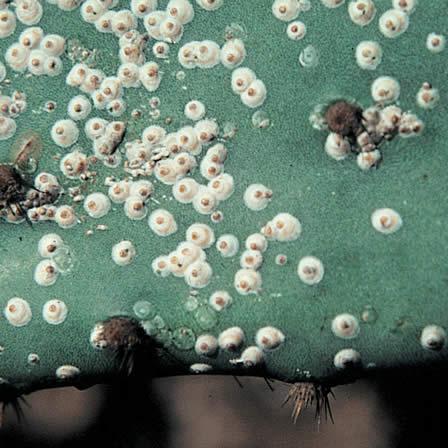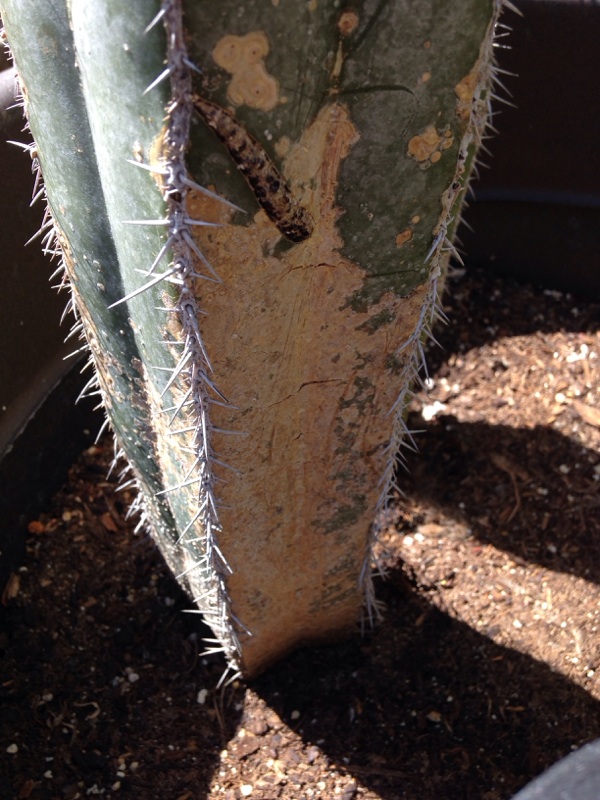If you have previously searched “How do you cure scales on cactus,” let me warn you that these can completely crust the plant’s surface. It is crucial to treat it properly and promptly; otherwise, it may weaken the plant and eventually cause it to die. You must be wondering what kind of insects these are. You might also be curious about the methods that can be effective in treating it. So let’s read the article in order to learn all of these topics.
The techniques listed below can be used to treat a variety of pests, not just scale. Your plant life would be protected if you were to stop them at an early stage so that they wouldn’t barge into your cactus.
Table of Contents
What is the cactus scale?
Scale insects that are affixed to the sap of cactus plants and consume it are known as cactus scales. However, the cactus scales contain a wide variety of species, like Dactylopious and Diaspis Chino Cacti, but because of their many similarities, it can be challenging to tell them apart.
It is important to note that when it comes to feeding, these insects first stick their mouths into the sweet sap and begin to drink it. It only impairs the plant’s look in the early stages. However, if the infection is severe, the plant may lose all strength and eventually perish.
What does cacti scale look like?
It is important to note that the armored cactus has dark scales that are either circular or oval when discussing looks. Additionally, these scales have a diameter of 1 cm. The soft scales, on the other hand, are smaller in comparison. They come in hues other than only black, brown, and gray.
The infestation of large scales on the surface of cactus leaves and stems resembles a mass of cottony whiteness. Here, we’ll go over a few typical symptoms.
What causes scale on cactus?
We shall discuss the reasons of scales on cactus in this section. Knowing the reasons and taking precautions to avoid them are absolutely essential. In North America, both native and imported succulents that contain cactus frequently have scales. The young scales that emerge from the eggs and are known as crawlers are laid by the adult females in the spring.
These crawlers mature and grow into adults throughout time. Then, like their parents, they relocate to other locations and begin consuming plant juices. Additionally, they expel honeydew, which are the little sugar droplets that accumulate on the vegetation below.
How do you treat scales on cactus?
Cactus scales, especially the armored variety, are tenacious and difficult to remove because they have an armored shell that performs a critical role in keeping predators at a distance.
Due to this rigidity, at least two treatments are required to completely liberate the plant from the cactus scales. However, if they are more severe, you might receive further treatments. All of your cactus plants are susceptible to damage from the cactus scales, so act quickly to prevent further plant loss.
Here, we’ll go through a few efficient methods for treating cactus scales. You should choose the method that works best for your situation based on the quantity of scales and type of plant.
1. Go for erasing the cactus scale manually
This is a really practical therapy approach. Use your fingernails or an old pair of credit card tweezers to remove the cactus scales.
Note that cactus scales behave very differently from other pests in that they don’t actively move about on their victim. Instead, it adheres to the stems and leaves. Additionally, it remains there for about two weeks before spreading to different plant regions.
As a result, it is a viable option that doesn’t necessitate too much effort. Always keep in mind that this method of treatment will only work if there are few insects around.
2. Apply Isopropyl Alcohol
Cactus scales and other pests that cause an infestation of succulent plants can be killed using the undiluted form of isopropyl alcohol. For plants that are more vulnerable to harm, using this scale-on-cactus treatment approach is advantageous. Therefore, using alternative treatment techniques could harm these plants.
This procedure involves mixing a few drops of dish soap with the equal volume of undiluted isopropyl alcohol and water. When you pour this mixture into a spray pump, your spray will be ready. The damaged cactus must then be sprayed with this solution all over. After waiting for ten minutes, you must remove the dead scales by scraping them off.
Repeat this procedure weekly until your plant is scale-free if you want the best results. It’s crucial to note that you can also use cotton swabs to disperse it throughout the colony.
Amazon is the best place to buy isopropyl alcohol.
3. Go for using insecticidal soap
A less hazardous alternative is insecticidal soap. It was frequently used by gardeners to get rid of scales and bugs. It is essentially a potassium salt with fatty acids in terms of composition. Fatty acids are added to chemical substances like alkalis to create it. Natural oils used to manufacture insecticidal soap contain these fatty acids.
One tablespoon of insecticidal soap should be added to one quart of water, or nearly four teaspoons should be added to a gallon of water. Apply this remedy to the plant’s diseased area. With the use of a soft brush, remove the dead scales after ten minutes. Repeat this procedure until the scales are gone, doing it once every seven days.
The best insecticidal soap is available on Amazon.
4. Biological Control
The term “biological control” refers to a method of pest management that relies on parasitism, herbivory predation, and other natural processes. Therefore, you must introduce ladybugs, lacewings, or Mealybug destroyers that can feed on scales with a soft body in order to treat scales.
Remember that the biological process has certain drawbacks as well. First off, using ladybugs and lacewings typically requires active human participation. Additionally, in the event of a widespread infestation, the treatment will be ineffective.
5. Pruning of affected parts
Another successful method of treating scales that are found on large cacti plants is pruning. It is crucial to define pruning in this context; it is the reduction or removal of plant portions that are dead or dying. To put it another way, we can say that eliminating plant parts that are harmful to the overall health or development of the plant or that lack an appealing aspect.
You must remove and prune the damaged stems and leaves. Additionally, if the entire plant is harmed and cannot be repaired, it must be promptly quarantined. If you put off quarantining it, the neighboring plants can suffer. Even after you’ve separated it, be sure to routinely inspect the other plants.
6. Practice Great Cultural Techniques
Plants can also fight off infections and diseases more successfully if they have a strong immune system. Because a healthy plant is more likely to resist bug and pest infestation, taking proper care of your plant is very important. In order to ensure that your plants thrive, make sure to give them ideal circumstances including sunlight, good drainage, and water.
In addition, you must maintain plant hygiene, which requires removing any leaves that are dead or decaying. Strong succulent stems and upright spines are indicators of a healthy cactus plant. It should also have leaves that are either greenish or blueish in color.
However, if you spot a white, brown, or gray clump on the surface of the leaves, it is a definite indication that something is wrong with your plant. Therefore, in this circumstance, you must seek medical attention in order to save your plant from the scales.
How do you stop scales on cactus?
Using insecticidal soap, which can be sprayed on the cactus leaves, you can prevent scales on cacti. Second, apply neem oil mixed with malathion if the cactus is completely covered in scales. This can stop the growth of scales on the cactus. The same applies to other plants, including succulents.
Insecticides and scale treatment options are widely available today. The link to a direct liquid that is ideal for treating scale and has a different formula may be found below.
Here is the pesticide and insecticide-infused horticulture oil. Aphids, insects, whiteflies, and scales are all controlled by it. These pests are targeted by the formulation of this remedy. It can be applied to any indoor or outdoor plant.
Shop on Amazon for concentrated insecticide/horticultural oil.
How fast does scale spread?
Keep in mind that while scale insect eggs and nymphs are small, most people are unable to detect their existence, and by the time they can, the population has already grown significantly.
Fortunately, they do not quickly harm the plants, giving you some time to receive treatment. They are not particularly destructive, nor are they particularly quick compared to other pests. However, you must exercise extreme caution and must keep a close check on your plant.
If you don’t take good care of your plant, it could suffer severe harm and you might have to give up having your favorite plant. Additionally, make sure the plant is pest-free before purchasing it. Make sure the soil is clean before adding it to the pot. Additionally, it is crucial NOT to leave your plants outside in the heat. Due to their small size, crawlers can enter through an open window, so make sure there is nowhere for scales to enter.
Do cactuses get scales?
The cactus does have scales. In essence, the scales are bugs that cling to the surface of the plant to feed. They are capable of attacking both indoor and outdoor plants. Occasionally, only a few scales attack, causing manageable harm. Treatment is the only option if you want to be in control of things; if not, they might reproduce and grow in number.
On the other hand, there are instances where they are numerous and can turn the entire surface of the plant white. Additionally, they run the risk of severely damaging the plant in this circumstance, which would result in its eventual death.
Types of scale insects
A large and diverse group of insects, scales have 8,000 known species. They are a member of the Coccidae family in the order Hemiptera. There are typically two different kinds of scales: soft scales and armored scales.
Soft Scales
When compared to the other category, the soft scales are more prominent, and indoor plants frequently have them. Soft scales have a circular to oval dome form and, once mature, range in size from 1/8 to 1/4 inch.
Armored Scales
The family Diaspididae includes the armored scales. They have a thick, waxy coating covering their entire body. They are smaller than soft scales, often measuring 1/16 to 1/18 inches.
Cactus Care
The finest possible plant care can play a vital part in maintaining the plant’s health, as we have already explained in this post. Your plant can thus fend off insects and other pests. Here are some pointers to help you with cactus maintenance:
Your cacti plant’s health will undoubtedly improve if you carefully implement all of these suggestions.
Eating cactus: purchase from Amazon.com.
Wrap Up
Snake Plant Spider Mites: How Do I Get Rid of Them?



